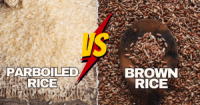Parboiled Rice vs Brown Rice is famous worldwide because it can grow in different places, gives a lot of energy, and can be used in many dishes. It’s also cheap and has some important nutrients. Knowing the difference between Parboiled Rice vs Brown Rice is important for cooking.
Brown rice takes longer and has a nutty taste and chewy feel. Parboiled rice cooks faster and is easier to digest. It has a mild taste and is in texture between Parboiled Rice vs Brown Rice. It also keeps more nutrients than white rice. Join us as we look closely at these two kinds of rice to help you pick the best one for your next meal. In the article “Parboiled Rice vs Brown Rice”, we’ll talk about the history, health benefits, and cooking uses of rice grains, giving you ideas and advice to make your dishes even better.
What Is Parboiled Rice, and How Is It Made?
Parboiled rice, or converted rice, is a special kind of rice. It’s made by soaking the rice in water, then steaming it and drying it before being turned into rice grains. This method helps the rice keep more nutrients and makes it firmer when cooked, not sticky like regular white rice.
First, the rice gets wet by soaking in water. Then, it’s steamed with hot steam, which goes into the outer part of the rice. After that, it gets dried to take out the extra water, so it doesn’t get too sticky when you cook it. The hard outer part is taken off, and what’s left is called “brown parboiled rice.” This is then made into the final parboiled rice. Parboiled rice is good because it keeps lots of the good stuff from the rice, like vitamins and minerals. It also stays firm when you cook it, and the grains don’t stick together too much.
What Is Brown Rice, and How Is It Made?
Brown rice is a whole grain known for its nutty flavor and superior nutrition compared to white rice. It retains its bran and germ layers, packed with fiber, vitamins, and minerals. The process involves threshing, milling to remove husk, and cleaning to eliminate impurities, leaving behind the nutritious brown rice kernel. Unlike white rice, it offers benefits like improved digestion and a lower glycemic index. Though it may require longer cooking and more water, the result is a wholesome grain essential in many cuisines.
Unveiling the Nutritional Showdown “Parboiled Rice vs Brown Rice”
Parboiled Rice vs Brown Rice are two different types of rice that undergo different processing methods, resulting in distinct characteristics and nutritional profiles. Here’s a breakdown of the differences between parboiled rice vs brown rice:
Parboiled Rice
Parboiled rice undergoes a unique process that involves soaking, steaming, and drying the rice grains before milling. During the parboiling process, the rice grains are partially cooked in their husks, which allows nutrients to migrate from the husk to the endosperm (the edible part of the rice).
Parboiled Rice: Parboiled rice is typically pale yellow or amber. The processing gives it a slightly translucent appearance.
Parboiled Rice: Parboiled rice grains are firmer and less sticky than white rice. They are fluffier and separate easily when cooked.
Parboiled Rice: Parboiled rice retains more nutrients than regular white rice because some of the nutrients from the husk are transferred to the endosperm during the parboiling process. It is a good source of complex carbohydrates and some minerals.
Parboiled Rice: Parboiled rice takes longer than regular white rice but less time than brown rice.
Parboiled Rice: Parboiled rice has a longer shelf life than brown rice because the process helps prevent the rancidity of the oils in the bran layer.
Brown Rice
Brown rice is whole-grain rice that has just had the inedible outer husk removed. It retains the bran layer and the germ, which contain valuable nutrients. Brown rice has a tan or light brown color due to the presence of the bran layer.
Brown Rice: Because of the bran layer, brown rice has a chewier texture. It can also be slightly nuttier in flavor compared to white rice.
Brown Rice: Due to the bran and germ layers, which are high in fiber, vitamins, minerals, and antioxidants, brown rice is one of the most nutrient-dense rice varieties.
Brown Rice: Brown rice has a longer cooking time than parboiled rice due to its intact bran layer.
Brown Rice: Because the oils in the bran of brown rice can get rancid over time, it has a lower shelf life.
What Are the Best Ways to Store Parboiled Rice vs Brown Rice?
Storing parboiled rice vs brown rice properly is crucial to maintain their quality and prevent spoilage. Here’s how to store them effectively:
- Store rice in a dry, cool area away from sunlight, heat, and humidity.
- Use airtight containers or sealed bags to keep out air and moisture.
- Opt for containers that are not transparent to protect rice from harmful sunlight.
- Consider using oxygen absorbers for long-term storage to maintain freshness.
- Keep rice at a cooler-than-average room temperature for prolonged shelf life.
- Prioritize using older rice before newer batches to ensure freshness.
- Avoid storing rice in the fridge, as it may become damp and lose flavor.
- To deter bugs, store rice in a clean environment and add bay or neem leaves.
- Label containers with rice type and storage date for easy monitoring.
- In humid environments, freezing rice in sealed containers is an option, though it may alter its texture.
Is Parboiled Rice Better Than Brown Rice?
The debate between parboiled rice vs brown rice often revolves around their nutritional value and processing methods. Parboiled rice undergoes a unique processing method that involves soaking, steaming, and drying before milling, while brown rice retains its bran and germ layers, providing ample fiber, vitamins, and minerals.
While both varieties have their own nutritional benefits, parboiled rice is often praised for its higher nutrient retention due to the parboiling process. It retains more vitamins and minerals, particularly B vitamins and iron, making it a nutrient-rich option.
However, brown rice is celebrated for its high fiber content, which promotes digestive health and aids in weight management. It also contains essential nutrients like magnesium, phosphorus, and selenium, contributing to overall well-being and disease prevention.
Ultimately, whether parboiled rice vs brown rice which one better its depends on individual preferences, dietary needs, and culinary requirements. Both varieties offer unique nutritional benefits and can be incorporated into a balanced diet for optimal health.
Conclusion
Understanding the differences between Parboiled Rice vs Brown Rice is crucial for making informed cooking choices. Parboiled rice retains more nutrients with its unique soaking, steaming, and drying process and offers a firmer texture than regular white rice. On the other hand, brown rice, with its intact bran and germ layers, provides enhanced nutritional value, a nuttier flavor, and a chewier texture. Both rice types have distinct advantages and can be stored effectively by following proper guidelines to maintain their quality and prevent spoilage. Choosing between these rice varieties depends on individual preferences and desired cooking outcomes, enriching the culinary experience with their diverse attributes.
FAQ’s
Q: Why is parboiled rice called “parboiled”?
- Parboiled rice is named as such because it undergoes a partial boiling process before milling. This process helps retain more nutrients in the rice grains.
Q: Can parboiled rice be substituted for brown rice in recipes?
- Yes, parboiled rice can be used as a substitute for brown rice in most recipes without significantly altering the taste or texture. However, it’s important to note that the cooking time may vary slightly.
Q: Which is better Parboiled Rice vs Brown Rice?
- Yes, brown rice is considered healthier than white rice because it retains its bran and germ layers, which are rich in nutrients and fiber. Parboiled rice, although processed differently, also offers nutritional benefits similar to brown rice.
Q: Does parboiled rice have a longer shelf life than brown rice?
- Yes, parboiled rice typically has a longer shelf life than brown rice due to its processing method, which enhances grain quality and reduces the risk of spoilage. However, both varieties should be stored properly in a cool, dry place to maintain freshness.
q: Are there any risks associated with consuming parboiled rice?
- While parboiled rice is generally safe for consumption, individuals with gluten allergies or sensitivities should be cautious, as rice may come into contact with gluten-containing grains during processing. Additionally, like any food product, proper cooking and storage practices should be followed to minimize the risk of foodborne illness.




I loved as much as you will receive carried out right here. The sketch is tasteful, your authored subject matter stylish. nonetheless, you command get got an edginess over that you wish be delivering the following. unwell unquestionably come further formerly again as exactly the same nearly very often inside case you shield this hike.
Pingback: Is Chipotle Queso Gluten Free - guestpostsellers
Pingback: Can a Rice Cooker Be Used as a Slow Cooker? - guestpostsellers